The emotional imbalance is a problem with many. A victim of such issues simply keeps on repeating mistakes, despite knowing everything. It can ruin someone’s effort even being on the brink of success. The issues of emotional imbalance leading to anger and sadness gradually lead to further larger issues like blood pressure, cardiac arrest, hypertension, stress, etc. However, regular practice of yoga and breathing techniques can indeed solve these. Given below are some of the best yoga poses that can help you in having control over your own emotions, anger, sadness, etc.

Anulom Vilom:
This is one of the most effective ways to release anger. It keeps the blood pressure level under control and rejuvenates the body cells through the proper supply of oxygen. To start with anulom-vilom, first sit normally in crossed leg state. Inhale deep through one of the nostrils gradually closing the others through your finger. Now remove the finger and exhale, while closing the other nostril through the finger. Repeat the process for at least 15 to 20 minutes every day with an empty stomach. It can be practiced in the evening as well. Close the eyes while doing it.
Savasana:
Savasana is another best yoga emotional release. It is one of the simplest options you can practice. Here the practitioner simply has to lie down on a flat surface, completely relaxing the body. Close the eyes and breathe without effort. Shift your entire focus on the breathing process. The prose relaxes the body and mind, keeping the blood pressure level under control.
Sarvangasana:
Sarvangasana is a very good physical yoga for anger release. The pose rejuvenates the brain cells through the proper supply of blood. Not just the brain, the pose helps in keeping the blood flow rate perfect for each part of the body. To start with, first, lie down on the ground keeping the legs straight.
Now lift both the legs jointly, keeping them straight, gradually at 30 degrees, then 60, 90, and ultimately erect the entire body making it perpendicular to the ground with the support of your hand on the back. It means the entire body has to stand on the shoulder. The vision should be on the toes. Stay as per your limit at this state and gradually come back to the initial state.
Bhramri:
Bhramri Pranayam is the most suitable yoga for emotional balance for the modern day people. It is a proven yoga for issues like high blood pressure, hypertension, stress, lack of focus, etc. Bhramri is a quite simple yoga that anyone can do. All it needs is to sit at crossed leg state, closing the ears through the thumbs and putting the other fingers on the eye. Now make a gentle sound inside, like a murmur or ‘mmmm…’ inside for each breathes.
Balasana:
Balasana is another most practiced yoga for emotional release. People having issues of hypertension and stress can also find it equally effective. The pose is very simple. First sit in Vajrasana (sitting on your calf, so that the buttocks remain on the heel), exhale and bend down to make the forehead touch the ground. Both the hands should remain at the either side of the body. You can breathe easy and stay to the extent you can.
Uttanasana:
Uttanasa can be a nice yoga to control emotions. It’s quite an easy pose that can be tried by people of every age group. Uttanasana also helps in improving the flexibility of the body. It enhances the blood flow to the brain and all another part of the body. To start with, stand straight, exhale and raise both the hand up. Now bend the upper body down gradually keeping the legs straight, without bending the knee, and hold the heel portion of your leg. Try to make the nose touch the knee.
Sukhasana:
Sukhasana is the easiest of all yoga forms to control emotions and anger. It’s a good recommendation for the beginners, prior starting meditation. There is nothing much to do here. You simply have to sit in crossed leg state, keeping the back straight. Fingers should be in proper mudra and on the thigh. Close the eye and put your entire focus on the breathing process.
